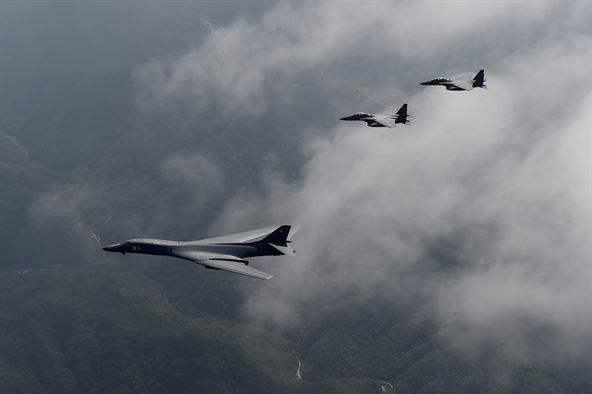As President Trump met with senior Defense officials on Tuesday to discuss America’s options regarding Kim Jong un’s North Korean regime, the wheels were already in motion for yet another show of force over the Korean Peninsula involving American and allied aircraft.
Late Tuesday night, U.S. Air Force B-1B Lancer bombers flew over the Korean Peninsula, escorted by South Korean F-15K fighter jets, before conducting air-to-ground missile drills just south of the North Korean border. They then flew off the coast of the peninsula, where they were joined by Japanese fighters, to conduct similar drills into the waters between South Korea and China. While these show of force flights are not uncommon, this marks the first time that nighttime missile drills have been conducted with both allied nations’ forces in the same evening. The U.S. Bombers then circled back and returned to Anderson Air Force Base in Guam.
The decision to execute these drills coincides with a higher frequency of what some call saber-rattling between President Donald Trump and North Korean Supreme Leader Kim Jong un. Trump has taken to calling his opponent “Rocket Man” in both social media and public addresses, and he’s even characterized Kim’s nuclear ambitions as a “suicide mission.” North Korea, not to be outdone by the rhetoric, has responded with a series of inflammatory accusations and threats throughout, including, at one point, claiming that President Trump had declared war via Twitter. This most recent flight, of course, was no different.
With his bellicose and insane statement at the United Nations, Trump, you can say, has lit the wick of a war against us,” North Korean Foreign Minister Ri Yong Ho said to the Russian owned outlet TASS. “We need to settle the final score, only with a hail of fire, not words.”
According to a White House statement, Trump held a meeting with defense officials on Tuesday night, including Secretary of Defense James Mattis and Chairman of the Joint Chiefs of Staff General Joseph Dunford, likely as the B-1Bs were already en route to the Korean peninsula from Guam. The meeting was reportedly to discuss the different military options that may be employed if prompted by North Korean aggression, or, according to the statement, to keep Pyongyang from threatening the U.S. and its allies with nuclear weapons. Kim Jong un, of course, has already issued a number of threats of preemptive nuclear strikes, in fact, for a time it was seemingly his response to every provocation, so it seems likely that the United States won’t take military action unless new threats are levied along with evidence to support the idea that Kim intends to follow through this time.
China has responded, once again, by calling for both North Korea and the United States to cease any further “provocative” action, a sentiment echoed in the Chinese “Global Times,” a state-controlled newspaper.
The international community won’t accept North Korea as a nuclear power. North Korea needs time and proof to believe that abandoning its nuclear program will contribute to its own political and economic advantage. This positive process is worth a try,” the Chinese paper wrote in an editorial released on Tuesday.
“War would be a nightmare for the Korean Peninsula and surrounding regions. We strongly urge North Korea and the U.S. to stop their bellicose posturing and seriously think about a peaceful solution,” it said.
Image courtesy of the U.S. Air Force
Already have an account? Sign In
Two ways to continue to read this article.
Subscribe
$1.99
every 4 weeks
- Unlimited access to all articles
- Support independent journalism
- Ad-free reading experience
Subscribe Now
Recurring Monthly. Cancel Anytime.











COMMENTS
You must become a subscriber or login to view or post comments on this article.